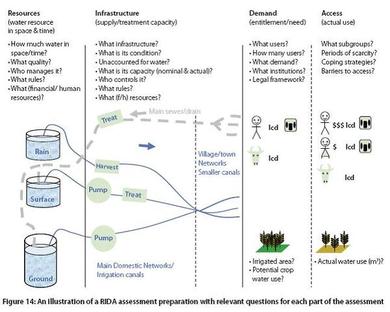Tool 9
TOOL 9. RIDA: ANALYSIS OF WATER RESOURCES, INFRASTRUCTURE, DEMAND AND ACCESS
To structure the collection and analysis of information about users demand for, and access to, water. This approach identifies barriers to meeting this demand and the potential to improve access within systems and institutions at the level of users, service providers, and water resource managers.
RIDA (water resources, infrastructure, demand and access) is not a tool in the true sense, but rather ananalytical frameworkthat helps to structure water-related information logically and transparently. This framework can be helpful for structuring data and information in the assessment phase, but also in the strategic planning phase.
The concept of RIDA is simple: users have multiple demands for water, and to meet these they usually rely on service providers (who manages infrastructure, like pipes and reservoirs), while both user and provider rely on natural water resources (rivers, lakes or underground sources) which must be managed and kept clean.
OBJECTIVE
To structure the collection and analysis of information about users demand for, and access to, water. This approach identifies barriers to meeting this demand and the potential to improve access within systems and institutions at the level of users, service providers, and water resource managers.
METHOD
Step 1: The starting point for using RIDA to structure a water resource assessment is to gather the necessary information to answer key questions relating to each element of the analysis.
These questions are about:
- Water resources
- What water resources are drawn on by the water supply infrastructure?
- What is the sustainable quantity of acceptable quality water that they can supply?
- Infrastructure
- What are the main physical elements of the water supply infrastructure (reservoirs, canals, treatment plants, pipe networks, etc.)?
- What is the capacity of this infrastructure (storage, treatment, supply) to meet demand?
- What institutions are related to water supply infrastructure?
- What major institutions are involved in managing water resources? What are their roles and responsibilities? How effective are they?
- Demand and access
- What is the demand for water from different water users and societal groups (quantity, quality, reliability, location)?
- What other demands are made upon them?
- What existing access do users have to water now and to what extent is demand satisfied?
- What are the key water-related institutions relevant to the various water-user groups?
- What barriers to access are experienced by different water-user groups (high user fees and requirement to have membership of associations, etc.)?
Step 2: Information collected during the RIDA analysis should be stored in an information database, most likely consisting of spread sheets and layers of information in a geographic information system (GIS layers). Ideally, the storage structure should reflect the RIDA elements, for example, by using different sheets within a spread sheet to summarise each RIDA element and another to draw together key data onto a single sheet.
Figure 6 An example of a RIDA analysis

Source: Moriarty, et al., 2007
TIPS AND TRICKS
- The boundaries between elements of RIDA are not always clear. For example, a large irrigation canal can be seen as infrastructure for an area, or as a water resource for a single village.
- Defining the boundaries between the RIDA elements is something that is best done in a local context as part of the stakeholder dialogue process.
- A key part of the assessment phase is deciding what information can be collected from existing secondary sources and what will require primary data. Typically, user-related data (demand, access, local institutions) requires mostly primary data, often collected using a range of PRA tools; while water resource data is usually collected from secondary sources. Information about infrastructure typically requires a mix of both.
- A RIDA process is an important part of awareness-raising. The key point is that people understand the full chain of resources, hardware and institutions involved in providing water services.
- Structuring analytical tools (such as models) and reports using RIDA help to bring stakeholders from different levels and interested in different elements of RIDA together in a joint analysis.
BASED ON
Moriarty, P. et al., 2007.The EMPOWERS Approach to Water Governance: Guidelines, Methods and Tools.Amman: INWRDAM.
SUGGESTED FURTHER READING
Case examples:
Adank, M. et al., 2011.Towards integrated urban water management in the Greater Accra Metropolitan Area, Current status and strategic directions for the future, Accra: SWITCH/RCN
Abebe, H. et al., 2010. Equitable water service for multiple uses, A case from Southern Nations Nationalities and Peoples Region(SNNPR). RiPPLE working paper 17. Addis Ababa RiPPLE. Available at:http://www.rippleethiopia.org/documents/stream/20100930-working-paper-17
